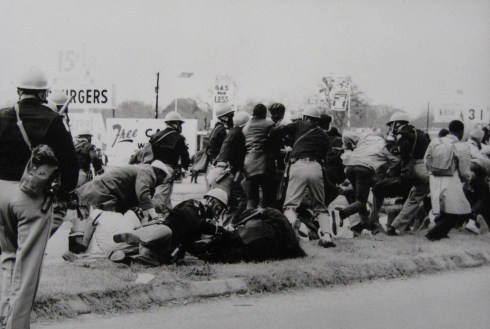Sheyann Webb’s account situates the youth, fear, and vulnerability of Black life in the march from Selma to Montgomery in 1965. In the first part of the interview, Webb addresses the advantages of her young age, “I had to report to my teachers because they were afraid,” she recalls. “They were just as afraid as my parents were, because they would lose their jobs” (Hampton 219). The white power structure in place in Selma controlled the actions of the employed Black middle class. Thus, Webb was able to participate in protests without fear of financial retaliation from white employers. Just as the act to participate in a protest is an act of self-preservation, many other Black adults viewed self-preservation as staying away from protest activities out of fear for their families and livelihoods. The white power structure’s suppression of Black voices compromised the ability of Black adults to advocate for their civil rights because they would jeopardize their employment and financial well-being.
Eight-year-old Webb was advised by her teachers not to be afraid, yet nothing could prepare her for marching right into the crossfire of police violence. However, Black children have been exposed to violence since long before the civil rights movement. For more than a century before Webb’s time, Black children had been depicted in popular culture as “pickaninnies”—older than they appear, insensate, and disposable. According to Robin Bernstein, “innocence had become the exclusive property of the vulnerable white child, while the pain-free pickaninny was exiled from innocence and with it, from childhood—and humanity” (68). To Selma’s police, Black children were no different than their adult counterparts who were protesting—thus, they justified their use of force by regarding Black children as insensate to pain. “All I could remember was outbursts of tear gas, and I saw people being beaten and I began to just try to run home as fast as I could,” Webb recalls of the violence on the Edmund Pettus Bridge (Hampton 228-229). Her ability to run to escape the violence and be rescued by a freedom fighter hinged on her able-bodied intuition to flee the site of violence used against nonviolent Black marchers. From her position kneeling at the top of the bridge, her vulnerability stemmed from fear at the approaching state troopers, billy clubs, and dogs. The physical and emotional vulnerability in her account is indicative of the precariousness of Black life in the face of police brutality.
Webb’s account reflects the precariousness of Black life due to the tendency for law enforcement personnel to see Black people as inherently deviant, disposable bodies. The act alone of peacefully opposing law enforcement personnel was viewed by the white power structure as deserving of violence and bodily harm. Furthermore, the mass gathering—however peaceful—of Black citizens posed a direct threat to law enforcement not only for their ability to engage in civil disobedience, but for their ability to organize with the intent to destroy the prevailing power structure. News reports from Selma featured children in the middle of violence not to evoke their innocence, but to portray them as “de-childed juvenile[s]” (Bernstein 55). The fact that an image of a fleeing Black child could be seen as devoid of innocence was indicative of a white mainstream media unable to perceive the pain felt by Black America in crisis.
Bernstein, Robin. "The Divergent Paths of Racial Innocence." Racial Innocence: Performing American Childhood from Slavery to Civil Rights. New York: New York UP, 2011. 30-69. Print.
Hampton, Henry, Judith Vecchione, et al. “Episode 6: Bridge to Freedom.” Eyes on the Prize I. Alexandria, Va.: PBS Video, 2006. <http://www.pbs.org/wgbh/amex/eyesontheprize/about/pt_106.html>.
Hampton, Henry, and Steve Fayer. Voices of Freedom: An Oral History of the Civil Rights Movement. New York: Bantam, 1990. 218-229. Print.
Webb, Sheyann. Interview by Blackside, Inc. Washington University Libraries, Film and Media Archive, Henry Hampton Collection.
